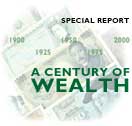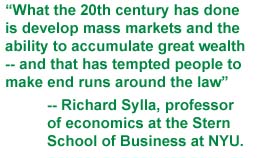|
A century of greed
|
 |
December 29, 1999: 9:39 a.m. ET
Scams, scandals and swindles: a look at the seamy side of 20th century wealth
By Staff Writer Martha Slud
|
NEW YORK (CNNfn) - Looking back on a century of unprecedented wealth creation and scores of rags-to-riches success stories that celebrate the American dream, there is, of course, another, darker tale to be told -- a hundred years of greed and scandal, swindles and scams, cons and crooks.
From relatively small-time frauds at the beginning of the century to major Wall Street insider trading scandals in the go-go 1980s, the past 100 years were rife with a notorious cast of characters who left their smudges on the world of business
Some were criminals who went to jail for their wrongdoing; others were speculators who simply miscalculated and lost millions -- or billions -- of other people’s money. Some scandals have sunk into oblivion, while a few episodes shook up the system enough to generate real financial reforms.

The human weakness for greed is as old as the species itself. But the economic growth and technological innovation that powered the 20th century provided the chaotic backdrop that allowed unseemly business activity to flourish, notes Richard Sylla, a professor of economics at the Stern School of Business at New York University.
Times of great innovation -- such as investor excitement over electric utilities in the 1920s or the growth of sophisticated financial tools such as derivatives in the 1980s and ‘90s -- have opened the door to wrongdoing or massive failure by people who may have had legitimate ideas initially but then went too far, Sylla said. Even such figures as Michael Milken, the demonized "junk-bond king,” was an innovator who changed the financial system by opening up a new market for high-yield securities issued by smaller companies, he said.
"What the 20th century has done is develop mass markets and the ability to accumulate great wealth -- and that has tempted people to make end runs around the law,” Sylla said. "So you see someone like (Barings Bank rogue trader) Nick Leeson, who toppled this very famous bank ... the shocking thing was one whippersnapper could do this.”
There are legions of stories of financial scandal throughout the century, but here are some of the most memorable:
One of the earliest of the century’s financial rogues was Italian immigrant Charles Ponzi, whose name has the dubious distinction in American business slang of denoting his particular type of fraud. The dapper Ponzi, who served time in Canada for forgery before setting up business in Boston and London, discovered he could buy international postal coupons abroad, then resell them in the U.S. for a higher price.
In what’s now known as a "Ponzi scheme,” or pyramid scheme, Ponzi pooled money from his initial investors, who made a profit off the venture, thus attracting more investors. But soon, Ponzi stopped buying the coupons altogether and paid off the early investors with the money poured in by the latecomers. Needless to say, the scheme ended poorly.
The stock market crash of 1929 and the Great Depression spurred the downfall of many dubious business enterprises. One of the biggest early 20th century scandals was the international scheme operated by Ivar Kreuger -- aka "the Swedish match king” -- who held a virtual monopoly over household match production in Europe. After World War I, Kreuger, backed by U.S. capital, loaned money to war-torn countries in exchange for monopoly rights in the match business. But Kreuger’s business began to founder amid the world financial tumult of the late 1920s, and in 1932 he committed suicide. After his death, it was discovered that his accounts were falsified - and U.S. investors had been fleeced out of millions through the fraud.

Meanwhile, one figure who survived major scandal was electricity tycoon Samuel Insull. Like the late ‘90s craze on Wall Street for Internet companies, the 1920s were marked by an obsession with the growth of electric utilities. The British-born Insull, head of Commonwealth Edison Co., built a utility empire though highly leveraged borrowing. He aggressively promoted his companies’ stocks, but the companies were toppled during the Depression and investors lost their shirts.
Insull fled to Europe in the 1930s, but was extradited to stand trial in Chicago for fraud and embezzlement. He was tried three times, but acquitted each time.
In the wake of the stock market crash, the newly formed Securities and Exchange Commission took on Wall Street, while Wall Street’s "Old Guard” strongly resisted the oversight. When the federal government unveiled new requirements on disclosure of personal finances, a former president of the New York Stock Exchange and one of its most prominent members, Richard Whitney, was found to have dipped into a pension fund for stock exchange employees and stolen from his own customers. Whitney pleaded guilty in 1938 to embezzlement charges and served time in federal prison.
The Whitney episode helped quiet Wall Street’s resistance to SEC regulation, Sylla notes, making it one of the century’s scandals that did result in major change. "When Wall Street sort of protested against the New Deal beating up on them, it was found that it (the Street) wasn’t as clean as supposed,” he said.
The 1940s through ‘60s were relatively quiet in terms of major financial scandal. "There’s a lull because of the Depression, which had kind of an equalizing effect,” says Paul Argenti, a professor of management and corporate communication at the Tuck School of Business Administration at Dartmouth College, who has studied greed in American culture.
One notable scandal during this era, however, was the federal indictment in the mid-‘60s of a group of major electrical manufacturers, including General Electric and Westinghouse, on price-fixing charges and conspiracy to fix government bidding on electrical equipment. The companies were forced to pay stiff antitrust penalties, some of the biggest fines ever levied by the government until then.
The1970s brought the scandal involving mutual fund syndicate Investors Overseas Services, founded by Bernard Cornfeld. After investors began to sell off during a market downturn, Cornfeld was replaced with financier Robert Vesco, who was accused of looting the company of $224 million and subsequently fled to the Caribbean. Vesco was later sentenced to a 13-year prison term in Cuba on unrelated charges stemming from allegations that he tried to produce and market a miracle cancer drug to overseas investors without the communist government’s knowledge.
The ‘80s: Wall St. scandal comes of age
In 1986, the SEC announced that Ivan Boesky, who engaged in a risky type of speculation called arbitrage, agreed to pay back $100 million and pleaded guilty to insider-trading violations. Boesky was later sentenced to three years in prison on one felony count of conspiracy to make fraudulent statements to the government.
One of the figures Boesky implicated was Michael Milken, the head of the junk-bond operation at investment bank Drexel Burnham Lambert Inc., who along with his firm was charged with securities fraud. Drexel went bankrupt, while Milken was sentenced to 10 years in prison.
The other big financial scandal of the ‘80s was the collapse of several savings-and-loan associations. The central figure of the debacle was Charles Keating Jr., the former chief executive of Lincoln Savings & Loan in Irvine, Calif., which was seized by regulators in 1989. Keating, convicted of securities fraud for allegedly looting the S&L and bilking investors of $200 million, served more than four years in prison before the charges against him were thrown out. After extensive legal wrangling, Keating agreed last April to plead guilty to four felony counts in a deal that will keep him from returning to prison.
In the ‘90s came the Barings affair, in which Singapore-based options trader Nick Leeson broke the 227-year-old bank by hiding $1.4 billion in trading debt he had accumulated. The Dutch financial group ING rescued Barings in 1995, and Leeson was released from prison earlier this year after serving a reduced term for fraud and conspiracy.

Nick Leeson talks to the press after his release from a Singapore prison in July 1999.
The past year has seen its share of financial sordidness. Martin Frankel, a Connecticut money manager, was arrested in Germany in September after a four-month international manhunt. Frankel is accused of bilking more than $200 million from insurance companies in five states and using the money to buy mansions, cars, diamonds and gold.
And just a couple weeks ago, the former chairman and CEO of Keefe, Bruyette & Woods Inc., James McDermott Jr., was arrested and charged with insider trading. Federal authorities allege that he passed inside investment tips to a porn actress with whom he had a relationship.
Risk takers
While not resulting in criminal charges, several of the century’s most notorious financial episodes involved financiers who saw huge opportunity for riches but ended up massively miscalculating.
In one case, the Hunt brothers -- Texas oilmen Nelson and William Hunt -- got in over their heads by trying to corner the market on silver. The run-up in prices, from less than $10 an ounce in mid-1979 to nearly $50 in early 1980, led people to sell heirlooms and melt down old silver quarters. But when the boom collapsed, the Hunt brothers ended up with about $1 billion in losses and charges of market manipulation by the Commodity Futures Trading Commission.
And last year, Wall Street was roiled by news that the multibillion-dollar hedge fund Long-Term Capital Management was near collapse. The fund, headed by Wall Street veteran John Meriwether, was nearly forced to liquidate billions of dollars in investments to meet minimum capital requirements before the Federal Reserve stepped in to negotiate a $3.6 billion bailout from top investment banks.
Who’s to blame?
So what is the end result of all of these episodes? Major business scandals and financial failures often bolster the public’s suspicion of Wall Street and corporate America, while some episodes have led to greater government oversight of business and the downfall of once high-flying moguls. But Sylla says that for the most part throughout the century, Americans have tended to brush off financial scandals unless their own self-interest is involved.
"These are people who are in some way crossing over the line, but as long as the economy is doing well, people say ‘that’s too bad,’” he said of the century’s gallery of rogues. "It’s when things aren’t going well, it’s then that we look for scapegoats and think that the government should have prevented all this from happening in the first place.” 
|
|
|
|
|
 |

|

